

How to Brainstorm in the Classroom. Brainstorming is an excellent teaching strategy to generate ideas on a given topic.

Brainstorming helps promote thinking skills. When students are asked to think of all things related to a concept, they are really being asked to stretch their thinking skills. All too often, a child with special learning needs will say they don't know. However, with the technique of brainstorming, the child says what comes to mind as it relates to the topic. Brainstorming promotes success for students with special needs as there is no one right answer. Let's say that the brainstorm topic is "weather", the students would state whatever comes to mind, which would most likely include words like rain, hot, cold, temperature, seasons, mild, cloudy, stormy, etc. How to Brainstorm in the Classroom.
8247ch10. Thinking and mind tools: De Bono's 6 Hats. Problem solving method poster srj. Copy of Copy of TESP Bachrach/Dumas 511 Week 6 Cooperative and Collaborative Learning Activities Fall 2020 - Google Slides. Peer Interaction Pedagogical Models. This week we will be learning about peer interaction pedagogical models.

The most utilized of the peer interaction models are cooperative and collaborative learning models. There are two major differences between cooperative and collaborative learning. The first major difference is that collaboration is a philosophical view on education through student centered interactive activities centered on working together towards an end. The process of working together is most valued in collaboration. TESP 511 Culturally Relevant Pedagogy Ingredients for Critical Teacher Reflection.pdf. Jesus Teaching Through Discovery. Exploratory Pedagogical Models. A note before we start: Everyone is learning the "Webquest" model, simply by interacting with this Webquest.
As such you will not be allowed to choose a "Webquest" for your teaching presentation/exploration. After brief exploration of the various exploratory models, choose the model you intend to use to teach the mini lesson. Click on the model below and navigate through all the links connected to that model. Keep in mind that you will need to create a 5-10 minute mini-lesson using your model, in order to teach your model, so explore all resources thoroughly. Inquiry Based Methods: Login section - Rollthedice.online. TeachingEnglishLearnersTheSIOPWay.pdf. SIOP Lesson Plan Templates.pdf. SIOP - Learn about SIOP.
What Is the SIOP Model?

The Sheltered Instruction Observation Protocol (SIOP) Model is a research-based and validated instructional model that has proven effective in addressing the academic needs of English learners throughout the United States. The SIOP Model consists of eight interrelated components: Lesson Preparation Building Background Comprehensible Input Strategies Interaction Practice/Application Lesson Delivery Review & Assessment Using instructional strategies connected to each of these components, teachers are able to design and deliver lessons that address the academic and linguistic needs of English learners.
Who benefits from SIOP instruction? As the number of English learners increases in schools across the United States, educators are seeking effective ways to help them succeed in K-12 ESL, content area, and bilingual classrooms. In addition, teachers report that SIOP-based teaching benefits all students, not just those who are learning English as an additional language. Best Apps and Websites for the Flipped Classroom. Reading the Wor(l)d Critical Literacy and Culturally Responsive Classroom Libraries.
A Beginner's Guide to Flipped Classroom. The Flipped Classroom is a blended learning model in which traditional ideas about classroom activities and homework are reversed, or "flipped. " In this model, instructors have students interact with new material for homework first. They then use class time to discuss the new information and put those ideas into practice. But don't be fooled. Merely flipping your homework and lecture doesn't mean you're unlocking all the benefits of flipped learning. True flipped learning is about opening up class time and transforming it into hands-on, differentiated, and even personalized learning experiences. This article provides an overview of the flipped classroom, and what you need to know to effectively incorporate into your digital learning strategy. History of the Flipped Classroom Although the flipped classroom is a highly talked about concept, it hasn’t been around for as long as you may think. Flipped Classroom vs. Flipping the Classroom.
“Flipping the classroom” has become something of a buzzword in the last several years, driven in part by high profile publications in The New York Times (Fitzpatrick, 2012); The Chronicle of Higher Education (Berrett, 2012); and Science (Mazur, 2009); In essence, “flipping the classroom” means that students gain first exposure to new material outside of class, usually via reading or lecture videos, and then use class time to do the harder work of assimilating that knowledge, perhaps through problem-solving, discussion, or debates.

In terms of Bloom’s revised taxonomy (2001), this means that students are doing the lower levels of cognitive work (gaining knowledge and comprehension) outside of class, and focusing on the higher forms of cognitive work (application, analysis, synthesis, and/or evaluation) in class, where they have the support of their peers and instructor. What is it? | Does it work? | Theoretical basis | Key Elements | Where can I learn more? | References What is it? 1. 2.